Association of PDYN 68-bp VNTR polymorphism with sublingual buprenorphine/naloxone treatment and with opioid or alcohol use disorder: Effect on craving, depression, anxiety and age onset of first use

View/
Access
info:eu-repo/semantics/openAccessDate
2022Author
Akyüzlü- Kaya, DilekKotiloğlu - Özkan, Selin
Şahiner- Yalçın, Şafak
İlhan- Özgür, İnci
Ertan- Ağtaş, Ece
Metadata
Show full item recordCitation
Kaya-Akyüzlü, D., Özkan-Kotiloğlu, S., Yalçın-Şahiner, Ş., Ağtaş-Ertan, E., & Özgür-İlhan, İ. (2022). Association of PDYN 68-bp VNTR polymorphism with sublingual buprenorphine/naloxone treatment and with opioid or alcohol use disorder: Effect on craving, depression, anxiety and age onset of first use. European Journal of Pharmacology, 921, 174862.Abstract
In this case-control study (423 Turkish subjects), the functional pro-dynorphin (PDYN) 68-bp VNTR polymorphism was genotyped in opioid users receiving sublingual buprenorphine/naloxone treatment (SBNT; n =
129, 119 males and 10 females), in opioid users (OUD; n = 99, 90 males and 9 females), in alcohol users (AUD; n
= 75, 75 males) and in controls (n = 120, 109 males and 11 females) to determine the effect of this polymorphism on different treatment responses, heroin or alcohol dependence as well as age onset of first use. The
PDYN 68-bp alleles were determined based on the number of repeats and genotypes were classified as “short/
short (SS)”, “short-long (SL)” and “long-long (LL)”. The intensity of craving, withdrawal, depression and anxiety
were measured by the Substance Craving Scale (SCS), the Clinical Opiate Withdrawal Scale (COWS), the Beck
Depression Inventory-II (BDI-II) and Beck Anxiety Inventory (BAI), respectively. Healthy controls (5.5 ± 5.8) had
significantly lower levels of depressive symptoms compared to OUD (25.4 ± 13.5), AUD (22.5 ± 11.3) and SBNT
(19.29 ± 12.2) groups. In OUD group, the LL genotype was associated with decreased intensity of anxiety and
depressive symptoms than the SS+SL genotype. The BDI-II scores for PDYN VNTR genotypes within the 4 groups
were analysed by two-way ANOVA and statistical differences were found for the groups. SBNT group had
significantly lower COWS score than OUD group (1.00 versus 3.00). There were statistically significant differences in the median BAI (11 versus 24) and BDI-II scores (17.5 versus 25) between OUD and SBNT groups,
supporting the antidepressant and anxiolytic effects of SBNT in persons with OUD.
Source
European Journal of PharmacologyVolume
921URI
https://doi.org/https://doi.org/10.1016/j.ejphar.2022.174862https://hdl.handle.net/20.500.12513/4425

















